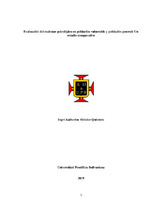Mostrar el registro sencillo del ítem
Evaluación del malestar psicológico en población vulnerable y población general: Un estudio comparativo
| dc.contributor.advisor | Director. Albarracín Rodríguez, Angela Pilar | |
| dc.contributor.author | Méndez Quintero, Ingri Katherine | |
| dc.coverage.temporal | 2019 | |
| dc.date.accessioned | 2021-01-21T14:32:45Z | |
| dc.date.available | 2021-01-21T14:32:45Z | |
| dc.date.issued | 2019-07 | |
| dc.identifier.uri | http://hdl.handle.net/20.500.11912/7493 | |
| dc.description | 42p.: (pdf); tablas; anexos. | spa |
| dc.description.abstract | El malestar psicológico consiste en una alteración secundaria de un evento estresor que no puede agruparse en un padecimiento sintomático porque no reúne los criterios propuestos dado que la persona experimenta su condición con incomodidad subjetiva. El presente estudio tuvo como objetivo evaluar el nivel de malestar psicológico en una muestra de personas en condición vulnerable y en una muestra de población general del área metropolitana de Bucaramanga. El diseño consistió en un enfoque cuantitativo, de tipo comparativo, transversal. Participaron 100 personas, que se clasificaron en 51 de población vulnerable y 49 de población general. Los instrumentos utilizados fueron el cuestionario de resultados terapéuticos (OQ) y Schwartz Outcome Scale – 10 (SOS). Los resultados evidenciaron que no existen diferencias estadísticamente significativas al comparar los puntajes de los cuestionarios entre la muestra de participantes de población vulnerable y la muestra de participantes de la población general. En conclusión, se infiere que independientemente del grupo al que pertenece el participante su manifestación de malestar psicológico es similar, lo cual puede ser atribuido al contexto particular colombiano. | spa |
| dc.description.abstract | Psychological distress consists in a secondary alteration of a stressor event that cannot be grouped into a symptomatic condition because it does not meet the proposed criteria given that the person experiences their condition with subjective discomfort. The objective of this study was to assess the level of psychological distress in a sample of people in vulnerable condition and in a sample of the general population of the metropolitan area of Bucaramanga. The design consisted of a quantitative approach, of a comparative, transversal type. 100 people participated, which were classified as 51 of vulnerable population and 49 of general population. The instruments used were the questionnaire of therapeutic results (OQ) and Schwartz Outcome Scale - 10 (SOS). The results showed that there are no statistically significant differences when comparing the scores between the sample of vulnerable population participants and the sample of participants from the general population. In conclusion, it is inferred that the group becomes the same place that is attributed to the particular Colombian context. | eng |
| dc.format.mimetype | application/pdf | |
| dc.language.iso | spa | |
| dc.publisher | Universidad Pontificia Bolivariana | spa |
| dc.rights | Attribution-NonCommercial-NoDerivatives 4.0 International | * |
| dc.rights.uri | http://creativecommons.org/licenses/by-nc-nd/4.0/ | * |
| dc.subject | Malestar psicológico | spa |
| dc.subject | Población vulnerable | spa |
| dc.subject | Población general | spa |
| dc.subject | Psicología - Estudio comparativo | spa |
| dc.title | Evaluación del malestar psicológico en población vulnerable y población general: Un estudio comparativo | spa |
| dc.type | Trabajo de grado | spa |
| dc.publisher.department | Escuela de Ciencias Sociales | spa |
| dc.publisher.program | Psicología | spa |
| dc.type.hasVersion | publishedVersion | spa |
| dc.description.sectional | Bucaramanga | spa |
| dc.description.degreename | Psicólogo | spa |
Ficheros en el ítem
Este ítem aparece en la(s) siguiente(s) colección(ones)
-
Trabajos de grado [6688]
Monografías, artículos, informes, proyecto de grado


